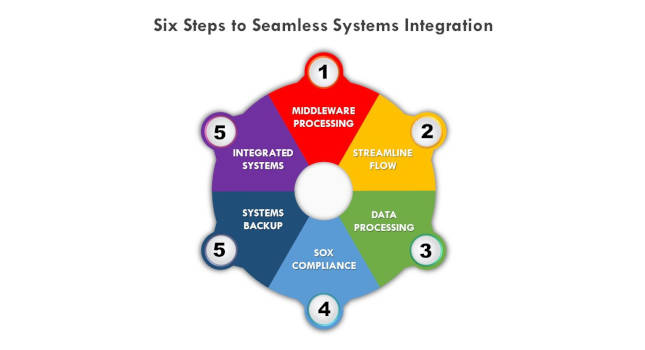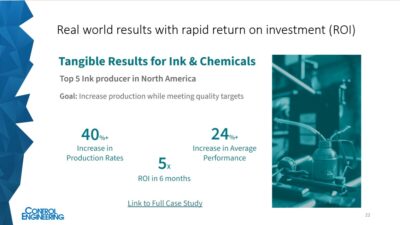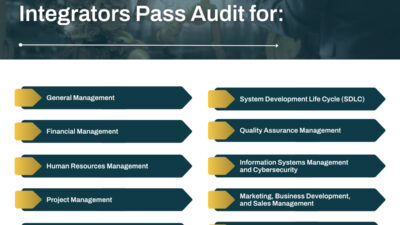Systems integration is a complex process that requires time, dedication, and the ability to take an objective look at the bigger picture.

Any plant manager will say that a centralized network is a game changer when it comes to successful manufacturing, facility management, and business operations. When devices and systems across and within departments easily communicate with each other, the organization is empowered with top-tier alignment that enables employees to focus on their own tasks, rather than interpreting others. At the same time, systems integration is a complex process that requires time, dedication, and the ability to take an objective look at the bigger picture.
Systems integration in a plant environment
The global system integration market size was valued at $327.70 billion in 2021 and is expected to grow at a compound annual growth rate (CAGR) of 13.2 % from 2022 to 2030. This steady growth stems from systems integration being a crucial solution for conducting business efficiently in an increasingly connected world. It refers to the process of taking sub-systems or devices and integrating them into one larger program to optimize processes. Systems can range from hardware, software, networking, and storage.
Systems integrators (SIs) work with colleagues across all areas of the company — everyone from administration to upper management to legal. After collecting and analyzing the appropriate data for corresponding departments’ internal or customer-facing procedures, SIs research and recommend systems, equipment, and technologies that integrate processes across the business seamlessly. From there, they create work plans, implement systems, curate documentation, and provide aftercare for clients to ensure integration is a success upon implementation and into the future. Their objective perspective helps to create solutions benefiting the entire company beyond the potential bias of departmental boundaries.
Businesses have been increasingly adopting cloud computing services alongside widespread utilization of the Internet of Things (IoT) and the COVID-19 pandemic furthered organizational needs for all systems within a business to integrate seamlessly.
In a plant environment, system integrators design and integrate computerized control systems for industrial machines, manufacturers, or facilities. Logistics vary depending on a company’s products and services. Plants manage thousands of processes a day, ranging from warehouse management, transfer of goods, heavy equipment, procurement, machine learning, sales, and distribution, on top of internal facets like human resources or legal. It’s too easy for vital information to slip through the cracks without well-developed systems integration.
A successful SI makes a detailed site assessment to determine what is working in the plant’s systems so far and what needs to change, with specifically tailored methods to integrate systems flawlessly. This includes understanding plant processes, the employees who implement those processes, and the technology behind it all. This must be seen as a requirement for the business by all involved parties, including alignment with the overall business mission and vision. Buy-in from key facility personnel who will adopt new systems or technologies is central to successful integration. Even perfectly integrated tech won’t succeed without committed teams. Ultimately, a SI listens, advises, and educates teams on how to better integrate all systems within a plant to best work together, to reduce manufacturing costs, and improve overall product and service quality.
Six key components of well-developed systems
While each industry uses different tools to improve their performance, productivity, and profitability, there are six key components of a well-developed systems integration system.
1. Ensure middleware is processing the data properly between systems.
Middleware is software positioned between an operating system and the applications running on it. Considered the “translation layer,” middleware enables communication and data management for distributed applications. This keeps data from being siloed to specific departments, keeps different software operating effectively together, and enables better communication between colleagues, customers, executives, vendors, and other stakeholders. Not all tools use the same code, so middleware is essential for business operations to run smoothly without relying on individuals to reenter or reinterpret information across teams or departments. Common needs for plants include database middleware, application server middleware, message-oriented middleware, web middleware, and transaction-processing monitors. Whether a company uses ten applications or two hundred, middleware acts as the link to keeping those applications talking to each other in the ways departments and their teams require.
When a company grows, it becomes even more necessary to leverage application integration middleware to establish an integration “hub,” as opposed to isolated middleware connections. This hub acts as a standardized way to connect all applications, application components, business processes, and back-end data sources. Today’s cloud-hosted model, called integration-platform-as-a-service (iPaaS), offers a solution for an organization to connect applications, data, processes, and services that exist on-location or in cloud environments without having to purchase, install, manage, and maintain integration middleware and its hardware within its own data center. Ensuring middleware is functioning properly necessitates consistent evaluation by those entering information on the front-end and across management review and approval, especially in a large plant environment.
2. Streamline end-to-end flow.
Successful end-to-end flow means information entered on the front-end is being easily processed through middleware and translated correctly and efficiently to the backend. Businesses want to make sure they’re using the right data collection, storage, and analytics methods, that queries to find data are correct in the first place, and users across the organization can access the results they need sooner rather than later. To streamline this process, it’s essential to perform strategic end-to-end system tests, which are a type of integration test that evaluates the flow of an application from start to finish. SIs implement end-to-end tests to identify system deficiencies and to ensure the right information is passed between various system components. End-to-end tests are meant to simulate the behavior of real users, so it’s vital for SIs to seek input from end users and test the wide net of possible interactions various users might have with a system.

3. Prioritize accurate and fast data processing.
While systems integration intends to make processes more efficient so users do not have to translate between programs on their own, there must be someone in place evaluating processes for efficiency. These individuals review performance and pinpoint where changes can be made. For example, there’s no point in having resources allocated to a program that is not being used or that is duplicating the work of another program. By removing unnecessary programs or optimizing processes for better efficiency, resources can be attributed to the processes that matter most, keeping data moving across programs quickly and accurately. Since all systems, even automated systems, act as a repository for information, accurate data on the front-end is crucial. A SI who can identify when and where data becomes inaccurate can save the organization vital time and resources.
4. Ensure all SOX compliances are met.
Compliance is a vital step to maintaining legal and ethical business practices. The 2002 Sarbanes-Oxley Act (SOX) established rules to protect the public from fraudulent or predatory practices by corporations and other business entities. Public companies are bound by law to show evidence of accurate, secured financial reporting via annual audits. Naturally, it’s essential to obey compliance laws to keep a business running, but SOX protections also enable a transparent relationship between a company and its employees and customers. When it comes to systems integration, transparency ensures all involved parties can start from an honest foundation that is understood throughout the organization. SOX mandates nine essential steps that include:
- Establish safeguards to prevent data tampering
- Establish safeguards to establish timelines
- Establish verifiable controls to track data access
- Ensure that safeguards are operational
- Periodically report the effectiveness of safeguards
- Detect security breaches
- Disclose security safeguards and breaches to SOX auditors
- Disclose failures of security safeguards to SOX auditors.
5. Ensure all systems have a backup service.
Any system needs a backup, so when something goes down, operations aren’t halted as the problem is fixed. This can be as specific as a vital piece of equipment, or as broad as the overall customer management database. When it comes to a large manufacturing system, if an important component stops functioning properly, the whole system is affected. For instance, if a plant’s robust, central mainframe goes down, even with the fastest troubleshooting, it can easily take thirty minutes to restart, with most facets of the business affected internally and externally in the interim. That half an hour can mean thousands of dollars, dissatisfied customers, or unsafe physical or digital environments for workers or customers. A well-established and consistently updated backup system is crucial to ensuring operations can run smoothly when disruptions inevitably arise, giving time for engineers and decision makers to locate the issue and create a viable, long-term solution.
However, just having a backup service isn’t enough. Consider that 75 percent of IT managers who had a backup system in place couldn’t restore all of their lost data and 23 percent of people with a backup solution couldn’t restore any data at all. Even Backup-as-a-Service (BaaS) companies state upfront that 60 percent of backups are incomplete and around half of the data restores can fail. Backup systems require consistent testing to ensure data is being successfully saved in a timely and efficient manner that offers real solutions when an outage, security breach, or system disruption happens. A detailed data recovery plan must be in place, especially in the case of a catastrophic data loss event. The bigger the organization, the more data and interconnected processes, so the more necessary it becomes to have multiple backup systems. Ninety-three percent of companies that suffer a major disaster and don’t have a recovery plan shut down within a year. Avoid that with detailed system alerts and a written backup strategy in place.
6. Implement appropriate approval levels and checkpoints between systems.
Integrated systems allow programs to talk to each other more easily, but often, users don’t need access to every part of a system. In fact, it can cause significant problems when unauthorized users access systems they’re unfamiliar with. Integrated systems operate best when restrictions are put in place to ensure users have access to only what they need and know how to use. Management needs the power to give approvals or extended access, when necessary, with a clear approval process in place so employees know who to go to and with what information. Built-in system alerts, checkpoints, and employee guides help users and their managers know when activities are outside the bounds of their role and where to go next to accomplish a necessary task.
Commitment is key
When it comes to daily plant operations, there are countless activities occurring across the organization at any given point in time. Imagine what can be accomplished when those actions are seamlessly integrated across a centralized system. Naturally, systems integration doesn’t happen quickly. To establish a system that easily communicates across all functions, ensure an ongoing commitment from systems integrators, engineers, decision-makers, and stakeholders. With that commitment in place, organizations will find success across plant efficiency and productivity, employee satisfaction, customer experience, and overall business growth.



